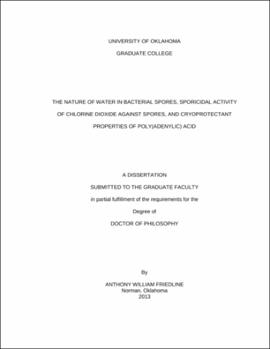| dc.contributor.advisor | Rice, Charles V | |
| dc.creator | Friedline, Anthony William | |
| dc.date.accessioned | 2019-04-27T21:21:12Z | |
| dc.date.available | 2019-04-27T21:21:12Z | |
| dc.date.issued | 2013 | |
| dc.identifier | 99120309702042 | |
| dc.identifier.uri | https://hdl.handle.net/11244/318469 | |
| dc.description.abstract | Water is the fundamental chemical molecule of life, and the nature of how water interacts with living organisms and how living organisms can maintain liquid water for metabolic function below freezing (cryoprotection) is of interest. In addition to psychrophilic microorganisms, the nature of water in the core of dormant bacterial spores is not clearly understood. If such mechanisms can be determined, they can be used for numerous methods, such as biocidal applications, or for preservation of tissue under freezing conditions. Such functions and cryoprotectant molecules may also have relevant implications for the theories of the origin of life on Earth which imply that such an origin occurred in colder conditions than exist today and the conditions oft theorized to occur on early Earth. | |
| dc.description.abstract | After an introduction into the RNA World hypothesis and its potential implication of a cold origin of life, and a discussion of extremophilic bacteria and their niches, this work will discuss previous research done in the Rice Group that determined the possibility that the Gram-positive cell wall component, teichoic acid, may possess cryoprotectant behavior, both in water by itself via NMR and fluorescence studies, but also in vitro with living bacteria. The similarity of the backbone of polyribonucleic acids, in particular poly(adenylic) acid, to the polyglycerolphosphate backbone of teichoic acids, led to research to determine if poly(A) also possessed cryoprotectant function based on this backbone structure. These experiments with rhodamine B-based fluorescence spectroscopy and variable-temperature deuterium NMR spectroscopy indicate the possibility that it may have similar cryoprotection effects with water. | |
| dc.description.abstract | The bacterial spore is able to protect its vital contents from chemical lysis, antimicrobial agents, heat damage, UV radiation, and dehydration. The role of spore components in spore protection remains in dispute; nevertheless, water molecules are important in each process. Water in the spore can be found free or bound in two different areas, core and non-core. Bound water in the spore has come under recent scrutiny; it is suggested the core water is mobile, rather than bound, based on analysis of deuterium relaxation rates. After background material on the structure of bacterial spores and the sporulation cycle, a set of experiments are discussed with the goal of using solid-state deuterium NMR spectroscopy to locate water inside of the spore and to determine its mobility through the spectral lineshape. Using this approach, we are able to distinguish between mobile and immobile deuterated water molecules inside of the spore. Deuterium NMR spectra of bacterial spores reveals three distinct features: a narrow line of water in rapid motion, a broad immobile signal associated with coat proteins, and an intermediate signal associated with core molecules such as dipicolinic acid. The immobility of the core-bound water associated with dipicolinic acid indicates that the core water is not mobile but is in an amorphous, glassy state. | |
| dc.description.abstract | In addition, the extreme viability of bacterial spores, including certain spore isolates, makes identifying sporicidal agents and their mechanisms of action also of relevance. Preliminary research will be presented on the effects of a proprietary stabilized chlorine dioxide-based biocidal agent, Oxine®, on bacterial spores. From SEM imagery of spores treated on glass cover slips, it appears that the mechanism of action of Oxine® is to penetrate the spore, possibly through chemical attack of the spore coat layers, and to dissolve the spore core, causing collapse of the spore structure. | |
| dc.format.extent | 199 pages | |
| dc.format.medium | application.pdf | |
| dc.language | en_US | |
| dc.relation.requires | Adobe Acrobat Reader | |
| dc.subject | Bacterial spores | |
| dc.subject | Water | |
| dc.subject | Chlorine dioxide | |
| dc.title | The Nature of Water in Bacterial Spores, Sporicidal Activity of Chlorine Dioxide, and Cryoprotectant Properties of Poly(adenylic) Acid | |
| dc.type | text | |
| dc.type | document | |
| dc.thesis.degree | Ph.D. | |
| ou.group | College of Arts and Sciences::Department of Chemistry and Biochemistry | |
